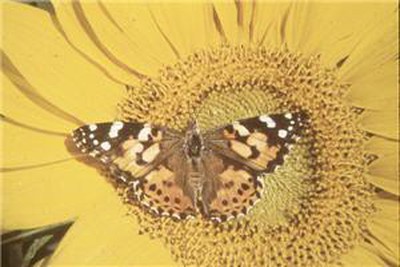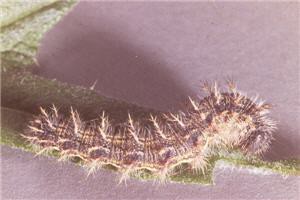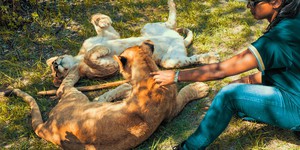Abstract
This is an interesting experiment if you are 1) curious about insect metamorphosis and 2) patient! You will need to set up different controlled environments for the chrysalides, and then check on them regularly as you wait for them to hatch.Summary
Andrew Olson, PhD, Science Buddies
Sources
This project is based on:
- Davidson, Z.A.M. (2003). The Butterfly's Secret: How Do Temperature and Light Affect the Time It Takes a Chrysalis to Hatch? California State Science Fair Abstract. Retrieved August 24, 2006.

Objective
The goal of this project is to determine the effect of temperature on butterfly metamorphosis; more specifically, on the time spent as pupa.
Introduction
All insects start out life as eggs (although some hatch within the body of the mother, and the young are born alive). As young insects grow and develop, their bodies change in a process called metamorphosis. In a few species—such as silverfish—only size changes. In other species, there is a simple change—development of wings in grasshoppers, for example. In the case of simple metamorphosis, the juvenile stages are called nymphs. In other insect species, there is a complete metamorphosis from a grub- or caterpillar-like larva to the adult body form (such as beetles and butterflies).
Nymphs and larvae pass through multiple stages of growth, called instars. Because insects must shed their exoskeleton in order to grow, each growth stage is separated by a molt (also called ecdysis). In complete metamorphosis, the last stage before adulthood is the pupa. Pupae are usually inactive, and do not feed. The pupa may have a protective coating—either a cocoon or chrysalis made by the larva—or a puparium, which is made of exoskeletal material.
Butterflies are an example of insects that undergo complete metamorphosis. One species of butterfly that is convenient to use for a science project is the painted lady. The caterpillars are cultured, and are available year-round. The adult butterflies are common in North America, and are unlikely to harm local ecosystems if released. The larval and adult stages are shown in Figures 1 and 2.

Figure 1. Larva of a painted lady butterfly.

Figure 2. Adult painted lady butterfly.
An adult female painted lady butterfly lays about 500 blue-green eggs on plants that the larvae will eat when they hatch. The eggs hatch in about 3–5 days. The larvae eat constantly, and pass through six instar stages (five molts) over about 12–18 days before pupating. The adults typically emerge in about ten days.
How does temperature affect the metamorphosis of painted lady pupae? How long will metamorphosis take if pupae are kept at cooler temperatures? How long will metamorphosis take if pupae are kept at warmer temperatures? In this project, you will experience the life cycle of a painted lady, from larva to butterfly, and measure the time spent as pupa for pupae placed in a cooler environment and for pupae placed in a warmer environment to find out.
Terms and Concepts
To do this project, you should do research that enables you to understand the following terms and concepts:
- Metamorphosis
- Nymph
- Instars
- Molt
- Pupa
- Cocoon
- Chrysalis
- Puparium
Questions
- What is the typical lifespan of a painted lady larva?
- How long does the pupal (chrysalis) stage typically last for painted lady butterflies?
Bibliography
- Borror, D.J. and R.E. White, 1970. Peterson Field Guides: Insects: A Field Guide to Insects, America North of Mexico. Boston, MA: Houghton Mifflin Company.
- Darmo, L. (n.d.). The Painted Lady Butterfly in the Classroom: Frequently Asked Questions. Departments of Living Zoology/Genetics, Carolina Biological Supply Company. Retrieved August 25, 2006.
- Queensland Museum Network. (n.d.). Insects. Retrieved March 3, 2015.
Materials and Equipment
To do this experiment you will need the following materials and equipment:
- 20–30 painted lady larvae:
- Available from an online supplier such as Carolina Biological catalog #144070. Note this kit includes food for the larvae.
- Plan ahead, it will take 2–3 weeks for the larvae to grow and pupate and then at least 10 more days for the butterfly to emerge from the chrysalis.
- It is possible to start from painted lady eggs; add an additional week for the eggs to hatch.
- Food for larvae:
- Available from the supplier from which you purchased the painted lady butterfly larvae.
- Can also be fed plant material (mallow and thistle are preferred in the wild);
- Container for housing larvae
- Hatching containers for housing chrysalides (2), available from an online supplier such as Carolina Biological catalog #144092. Alternatively, two hatching containers can be made in the following manner:
- Use cardboard boxes (2) open at the top for light, with air holes punched in sides, and the top covered by plastic mesh or screen material.
- Make an access flap at the bottom of one side for feeding the adults fresh sugar water (see Experimental Procedure for details).
- Lean a perching twig or stick against the side of the box.
- For feeding adult butterflies you will need:
- Sponge
- Sugar or honey
- Water
- Lid from a jar or plastic food container
- Thermometer, can be ordered from an online supplier such as Carolina Biological catalog #745380.
- 1 warm environment (such as indoors at approximately 20°C),
- 1 cool environment:
- The temperature should definitely be above freezing (0°C).
- Depending on the time of year and your location, this could be an unheated garage, porch, outdoors, or some type of insulated cooler setup.
- Keep the containers away from direct sunlight, which will cause the temperature to rise and then fall as the day proceeds.
- For an insulated cooler you could try placing the hatching container inside an open ice chest with a bag of ice in the bottom, covered by a layer of corrugated cardboard or some crumpled newspaper. Surrounding the inner box with crumpled newspaper insulation may help as well. In a quick test, our open cooler setup reduced ambient temperature by a little more than 3°C, and the ice lasted for many hours. Check with a thermometer to make sure your setup maintains the inner box at the desired temperature. You will have to periodically replenish the ice and dump melt water; check it several times per day at the beginning and then as needed once you see how fast the ice melts.
- Lab notebook
Disclaimer: Science Buddies participates in affiliate programs with Home Science Tools, Amazon.com, Carolina Biological, and Jameco Electronics. Proceeds from the affiliate programs help support Science Buddies, a 501(c)(3) public charity, and keep our resources free for everyone. Our top priority is student learning. If you have any comments (positive or negative) related to purchases you've made for science projects from recommendations on our site, please let us know. Write to us at scibuddy@sciencebuddies.org.
Experimental Procedure
- Do your background research and make sure that you understand the terms, concepts, and questions.
- Follow the directions that come with your larvae for feeding and housing them. Monitor them regularly, making sure they have sufficient food and water and that their surroundings are clean.
- Record any observations you make in your lab notebook. For example, note the number of larvae that have molted (by counting the shed exoskeletons). Do the larvae eat the discarded exoskeletons? Note: The details of these observations do not need to go on your display board, as in this science project, you are studying the time spent as a pupa.
- Be sure to note when the larvae start to pupate. Label each chrysalis with a number (attach a small paper label with a dab of white glue).
- Carefully remove each chrysalis, placing it in one of the two hatching containers (alternate between the warm and cool containers).
- Make a table in your lab notebook to keep track of the chrysalides by number. Record the date each chrysalis was made and daily observations. For each chrysalis, record the date when the adult butterfly emerges.
- You should also track the temperature of each hatching container at regular intervals each day.
- Figure out the pupation time for each chrysalis by counting the number of days from pupation to hatching.
- Once the adults emerge, they will need liquid food. Here is how to feed them:
- Cut a sponge into small pieces of about 4 centimeters (cm) square.
- Saturate the sponge with a sugar-water solution (1 teaspoon sugar or honey in 1/2 cup water).
- Place the sponge in a shallow dish (lid from a jar or plastic food container).
- Every day, rinse the sponge in fresh water, squeeze out the excess, and saturate it again with sugar water (doing this prevents mold from growing on the sponge).
- Calculate the average and standard deviation of the pupation time for each group of chrysalides. Make a graph of pupation time vs. temperature.
- How much of a difference does temperature make?
- Count the number of pupae that survive to adulthood in each group. What is the survival rate? Is there a difference between the two groups?
- Do you notice any other differences between the two groups of butterflies?
- When your experiment is over, you can release the adults, if this is legal where you live.
- If you do not wish to keep the butterflies, nor release them, we recommend the following method to humanely kill them:
- First, place the butterflies in a refrigerator for several hours to slow down their metabolism, then place them in a freezer overnight.
- Since painted lady butterflies are cold-blooded, and are routinely exposed to chilling weather in the spring and fall, this method will not cause distress or pain to the butterflies.
Ask an Expert
Global Connections
The United Nations Sustainable Development Goals (UNSDGs) are a blueprint to achieve a better and more sustainable future for all.
Variations
- Try increasing the number of temperatures tested. Devise a way to warm some of the chrysalides. Perhaps you could use a heating pad on a low setting or a small heat lamp (like those used for a reptile cage) to warm up a box. Make a graph of pupation time vs. temperature. What is the relationship?
- Extend the experiment to include the larva stage. What effect does temperature have on larvae growth, molting, and initiation of pupation? Raise larvae at three different temperatures: cooler than room temperature, room temperature, and warmer than room temperature. Try to avoid lethal extremes of temperature. Weigh the larvae at regular intervals and calculate the average growth rate of each group. Make a graph of growth rate vs. temperature. What is the relationship? How many larvae from each group successfully pupate and develop into adults? What is the average size and weight of each adult?
- Do differences in temperature during the pupa stage result in different wing scale patterns? Learn how to mount butterflies (do an internet search on "mounting butterflies" and you will find plenty of resources) so that you can make a careful comparison of your specimens.
Careers
If you like this project, you might enjoy exploring these related careers:







